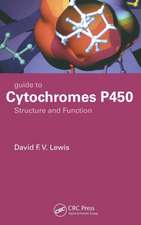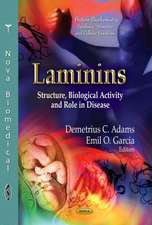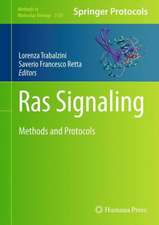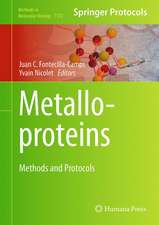Phospholipid Signaling Protocols: Methods in Molecular Biology, cartea 105
Editat de Ian Birden Limba Engleză Hardback – 15 apr 1998
| Toate formatele și edițiile | Preț | Express |
|---|---|---|
| Paperback (1) | 644.49 lei 43-57 zile | |
| Humana Press Inc. – 23 aug 2013 | 644.49 lei 43-57 zile | |
| Hardback (1) | 655.13 lei 43-57 zile | |
| Humana Press Inc. – 15 apr 1998 | 655.13 lei 43-57 zile |
Din seria Methods in Molecular Biology
- 9%
 Preț: 791.59 lei
Preț: 791.59 lei - 23%
 Preț: 598.56 lei
Preț: 598.56 lei - 20%
 Preț: 882.95 lei
Preț: 882.95 lei -
 Preț: 252.04 lei
Preț: 252.04 lei - 5%
 Preț: 802.69 lei
Preț: 802.69 lei - 5%
 Preț: 729.61 lei
Preț: 729.61 lei - 5%
 Preț: 731.43 lei
Preț: 731.43 lei - 5%
 Preț: 741.30 lei
Preț: 741.30 lei - 5%
 Preț: 747.16 lei
Preț: 747.16 lei - 15%
 Preț: 663.45 lei
Preț: 663.45 lei - 18%
 Preț: 1025.34 lei
Preț: 1025.34 lei - 5%
 Preț: 734.57 lei
Preț: 734.57 lei - 18%
 Preț: 914.20 lei
Preț: 914.20 lei - 15%
 Preț: 664.61 lei
Preț: 664.61 lei - 15%
 Preț: 654.12 lei
Preț: 654.12 lei - 18%
 Preț: 1414.74 lei
Preț: 1414.74 lei - 5%
 Preț: 742.60 lei
Preț: 742.60 lei - 20%
 Preț: 821.63 lei
Preț: 821.63 lei - 18%
 Preț: 972.30 lei
Preț: 972.30 lei - 15%
 Preț: 660.49 lei
Preț: 660.49 lei - 5%
 Preț: 738.41 lei
Preț: 738.41 lei - 18%
 Preț: 984.92 lei
Preț: 984.92 lei - 5%
 Preț: 733.29 lei
Preț: 733.29 lei -
 Preț: 392.58 lei
Preț: 392.58 lei - 5%
 Preț: 746.26 lei
Preț: 746.26 lei - 18%
 Preț: 962.66 lei
Preț: 962.66 lei - 23%
 Preț: 860.21 lei
Preț: 860.21 lei - 15%
 Preț: 652.64 lei
Preț: 652.64 lei - 5%
 Preț: 1055.50 lei
Preț: 1055.50 lei - 23%
 Preț: 883.85 lei
Preț: 883.85 lei - 19%
 Preț: 491.88 lei
Preț: 491.88 lei - 5%
 Preț: 1038.84 lei
Preț: 1038.84 lei - 5%
 Preț: 524.15 lei
Preț: 524.15 lei - 18%
 Preț: 2122.34 lei
Preț: 2122.34 lei - 5%
 Preț: 1299.23 lei
Preț: 1299.23 lei - 5%
 Preț: 1339.10 lei
Preț: 1339.10 lei - 18%
 Preț: 1390.26 lei
Preț: 1390.26 lei - 18%
 Preț: 1395.63 lei
Preț: 1395.63 lei - 18%
 Preț: 1129.65 lei
Preț: 1129.65 lei - 18%
 Preț: 1408.26 lei
Preț: 1408.26 lei - 18%
 Preț: 1124.92 lei
Preț: 1124.92 lei - 18%
 Preț: 966.27 lei
Preț: 966.27 lei - 5%
 Preț: 1299.99 lei
Preț: 1299.99 lei - 5%
 Preț: 1108.51 lei
Preț: 1108.51 lei - 5%
 Preț: 983.72 lei
Preț: 983.72 lei - 5%
 Preț: 728.16 lei
Preț: 728.16 lei - 18%
 Preț: 1118.62 lei
Preț: 1118.62 lei - 18%
 Preț: 955.25 lei
Preț: 955.25 lei - 5%
 Preț: 1035.60 lei
Preț: 1035.60 lei - 18%
 Preț: 1400.35 lei
Preț: 1400.35 lei
Preț: 655.13 lei
Preț vechi: 770.73 lei
-15% Nou
Puncte Express: 983
Preț estimativ în valută:
125.36€ • 131.22$ • 104.34£
125.36€ • 131.22$ • 104.34£
Carte tipărită la comandă
Livrare economică 31 martie-14 aprilie
Preluare comenzi: 021 569.72.76
Specificații
ISBN-13: 9780896034914
ISBN-10: 0896034917
Pagini: 380
Ilustrații: XIII, 380 p. 22 illus.
Dimensiuni: 152 x 229 x 30 mm
Greutate: 0.83 kg
Ediția:1998
Editura: Humana Press Inc.
Colecția Humana
Seria Methods in Molecular Biology
Locul publicării:Totowa, NJ, United States
ISBN-10: 0896034917
Pagini: 380
Ilustrații: XIII, 380 p. 22 illus.
Dimensiuni: 152 x 229 x 30 mm
Greutate: 0.83 kg
Ediția:1998
Editura: Humana Press Inc.
Colecția Humana
Seria Methods in Molecular Biology
Locul publicării:Totowa, NJ, United States
Public țintă
ResearchCuprins
Monitoring of Activation of Phospholipid-Derived Cell Signaling Pathways.- Phosphoinositidase C Activation Assay I.- Phosphoinositidase C Activation Assay II.- Phosphoinositidase C Activation Assay III.- Measurement of Phosphoinositols and Phosphoinositides Using Radio High-Performance Liquid Chromatography Flow Detection.- Preparation of [3H]Phosphoinositol Standards and Conversion of [3H]Phosphoinositides to [3H]Phosphoinositols.- Inositol 1,4,5-Trisphosphate Mass Assay.- Measurement of Cellular Diacylglycerol Content.- Phosphatidylinositol 4-Kinases.- Phosphatidylinositol(3,4,5)Trisphosphate (Ptdins(3,4,5)P3) Mass Measurement Using a Radioligand Displacement Assay.- Detection of Phosphatidylinositol-4-Phosphate 5-Kinase Activity Using Thin-Layer Chromatography.- Determination of Phospholipase C-or Phospholipase D-Catalyzed Phosphatidylcholine Hydrolysis.- Measurement of Phospholipase D Activity.- Monitoring of Phospholipase A2 Activation in Cultured Cells Using Tritiated Arachidonic Acid.- Assay of Cellular Diacylglycerol and Monoacylglycerol Lipases.- Isotopic Efflux Studies as Indices of Phospholipase Activation.- Extraction and Measurements of Prostanoids and Leukotrienes by Radioimmunoassays.- Measurements of Prostanoids, Leukotrienes, and Isoprostanes by Enzyme Immunoassays.- Measurements of Arachidonic Acid Metabolites Derived from the Lipoxygenase Pathways by High-Pressure Liquid Chromatography.- Measurement of Sphingomyelin and Ceramide Cellular Levels After Sphingomyelinase-Mediated Sphingomyelin Hydrolysis.- Sphingomyelin and Ceramide Mass Assay.- Sphingosine Kinase.- Analytical Methods and Steps to Sample Preparation for Determination of Molecular Species of Fatty Acids.- HPLC Analytical Methods for the Separation of Molecular Species of Fatty Acids in Diacylglycerol and Cellular Phospholipids.- Analysis of Molecular Species of Cellular Sphingomyelins and Ceramides.- General Methods for Monitoring Changes in Levels of Key Signaling Pathway Proteins and Associated mRNA.- Solubilization and Assay of Cellular and Tissue Protein.- Western Immunoblot Analysis.- Immunohistochemistry and Immunocytochemistry.- Extraction of Cellular and Tissue RNA.- Size Separation and Quantification of mRNA by Northern Analysis.- Preparation of Single-Stranded Antisense cDNA Probes by Asymmetric PCR.- Optimization of a Reverse Transcription-Polymerase Chain Reaction (RT-PCR) Mass Assay for Low-Abundance mRNA.
Recenzii
". . . the detailed information provided in Phospholipid Signaling Protocols makes it a welcome addition to an academic library that serves scientists actively working in the area of second messenger and membrane lipid chemistry. It is well representative of the previous volumes in the Methods in Molecular Biology series, and therefore is a worthwhile acquisition."-E-Streams
". . .this book is an extremely valuable resource for methodology in studying the molecular species of key phospholipid signaling molecules, as well as the enzymes that produce or degrade them. I personally have used several protocols in this book, and have not had any trouble adapting the methods to my own applications."-The Quarterly Review of Biology
"...gives an excellent overview of the most common techniques in use as well in biochemistry and molecular biology...The editor is to be congratulated for putting these diverse, very important protocols together..."-Cell Biology International 2000
"...does a very good job of covering what is a fairly diverse field and the protocols described would allow any well equipped laboratory to tackle lipid analysis. There are currently very few books on the market addressing this important area of biochemistry and this volume would be a valuable addition to the collection of any laboratory studying lipid signaling molecules."-Molecular Biotechnology
"...does a very good job covering what is a fairly diverse field and the protocols described would allow any well equipped laboratory to tackle lipid analysis. There are currently very few books on the market addressing this important area of biochemistry and this volume would be a valuable addition to the collection of any laboratory studying lipid signalling molecules." - Molecular Biotechnology
". . .this book is an extremely valuable resource for methodology in studying the molecular species of key phospholipid signaling molecules, as well as the enzymes that produce or degrade them. I personally have used several protocols in this book, and have not had any trouble adapting the methods to my own applications."-The Quarterly Review of Biology
"...gives an excellent overview of the most common techniques in use as well in biochemistry and molecular biology...The editor is to be congratulated for putting these diverse, very important protocols together..."-Cell Biology International 2000
"...does a very good job of covering what is a fairly diverse field and the protocols described would allow any well equipped laboratory to tackle lipid analysis. There are currently very few books on the market addressing this important area of biochemistry and this volume would be a valuable addition to the collection of any laboratory studying lipid signaling molecules."-Molecular Biotechnology
"...does a very good job covering what is a fairly diverse field and the protocols described would allow any well equipped laboratory to tackle lipid analysis. There are currently very few books on the market addressing this important area of biochemistry and this volume would be a valuable addition to the collection of any laboratory studying lipid signalling molecules." - Molecular Biotechnology
Textul de pe ultima copertă
In Phospholipid Signaling Protocols, state-of-the-art techniques for monitoring the major lipid and phospholipid-derived second messenger pathways to identify and quantify pathway activation are detailed by experts intimately experienced in their use. The assays described cover all the major phospholipases (C, D, A2), as well as sphingomyelinase and its associated metabolites. Additional protocols are provided for the assay of phosphoinositide 3-, 4-, and 5-kinase and sphingosine kinase activity, and for the quantification, separation, and rigorous identification of phospholipids, diacylglycerol, and sphingolipids, as well as their metabolites, including phosphoinositols, choline metabolites, and fatty acid metabolites. In addition, there is extensive information on the extraction, size separation, detection, and quantification of cellular signaling proteins and corresponding mRNA, as well as a description of their localization by immunohistochemistry and immunocytochemistry.
Phospholipid Signaling Protocols offers a wide-ranging collection of cutting-edge techniques for the study of signal transduction through phospholipid intermediates and their metabolites. The book is an indispensable reference for both the newcomer and the experienced researcher seeking to expand knowledge of these critical pathways, and strongly complements its companion volumes-R.A.J. Challiss' Receptor Signal Transduction Protocols, D. Bar-Sagi's, Transmembrane Signaling Protocols, and D. A. Kendall and S.J. Hill's Signal Transduction Protocols-in building a unique library of tried-and-tested protocols relating to the ever expanding signal transduction field.
Phospholipid Signaling Protocols offers a wide-ranging collection of cutting-edge techniques for the study of signal transduction through phospholipid intermediates and their metabolites. The book is an indispensable reference for both the newcomer and the experienced researcher seeking to expand knowledge of these critical pathways, and strongly complements its companion volumes-R.A.J. Challiss' Receptor Signal Transduction Protocols, D. Bar-Sagi's, Transmembrane Signaling Protocols, and D. A. Kendall and S.J. Hill's Signal Transduction Protocols-in building a unique library of tried-and-tested protocols relating to the ever expanding signal transduction field.


















